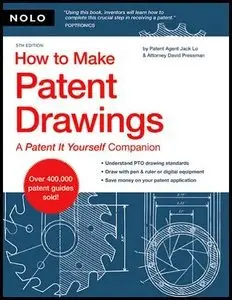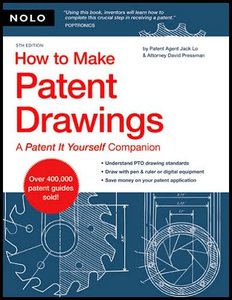Jack Lo, David Pressman, "How to Make Patent Drawings: A Patent It Yourself Companion"
N.OLO | 2007 | ISBN: 1413306535 | 241 pages | PDF | 6,5 MB
N.OLO | 2007 | ISBN: 1413306535 | 241 pages | PDF | 6,5 MB
Patent drafters charge $75 to $100 per sheet to prepare drawings – but you can draw them yourself!
How to Make Patent Drawings is an essential guide for inventors who want to complete a crucial step in the patenting process themselves – creating formal patent drawings that comply with the strict rules of the U.S. Patent and Trademark Office (and save hundreds or even thousands of dollars).
Written by two experts in the patent field, How to Make Patent Drawings shows you how to:
make utility patent drawings make design patent drawings utilize pen and paper, or digital equipment respond to Patent Office Actions regarding drawings Plus, once you've secured a patent with your drawings, you can also use them to market and promote your product to prospective manufacturers and customers. The 5th edition is completely updated to reflect recent changes to patent law and the newest advances in technical drawing. It includes all necessary forms, plus step-by-step instructions for filling them out. Summary: Good BookRating: 5This book is well written and up to date. I needed detailed information on shading and it was covered very well. If your new to patent drawings, this is covers the subject well. Summary: A lot of information in one bookRating: 4I bought this book and Patent Pending in 24 Hours. The latter was a complete disappointment (read my review of it). This book however, was fairly detailed and answered quite a few questions for me. I am trained as a Graphic Designer. So I was very interested in doing the drawings myself on the computer. While the book focuses on traditional drawings for the most part, the information is still relevant for computer drawings. The book tells you what parts you need to draw and what to leave out. It also talks about how to shade the different elements. Which is one of the major things the examiner uses to differentiate the parts of your invention that connect or are attached. The book also goes into detail about how to label your figures and numbering of parts. The one thing that did bother me about this book is that more than once they tell you to reference Patent It Yourself for more information. I bought this book because it implies that it will tell you everything you need to know about making patent drawings. I thought it was ridiculous that they spread the information out into their other book as a ploy to make more money. Luckily, there is enough information here to do what you need to do. Overall I thought the book is a good collection of information. Despite the references to their other book. Summary: Patent DrawingRating: 5I found this book to be excellent. Lot's of information and concisely written. A MUST reference if you are planning to make your own patents. Some good info on CAD drafting software, also. Summary: Do It Right - Do It Yourself - And Save Money!Rating: 5On the last couple of patent applications I submitted, I ended up doing 90% of the drawings myself because it turned out to be easier than continuously having to correct the mistakes of the draftsman. My attorney said that my drawings just needed to be shaded and cleaned up a bit, and have the legends applied, but otherwise what ended up going into the applications was essentially my drawings with a few more bells and whistles. His draftsman had just put them on a light table and copied them as is. But I still had to pay for the drawings! This book was able to get me the rest of the way there by detailing the regulations that the USPTO puts on drawings. They're not really difficult, but they ARE specific. Don't be intimidated by them. The very simple drawing style specified by the USPTO is to allow clear reproduction and printing. My attorney charges $295 per figure, and one page can have 2 or 3 figures on it! The last application we submitted had about a dozen figures total. Some of the expense is the work of integrating and describing the drawings, but it is guaranteed to save you money if you do your own drawings. Besides, this ensures that you will be satisfied with the quality and accuracy. Don't forget you can also have the draftsman do the difficult 3-D "Figure 1" bit, and you do the simpler stuff. Like me, I'll bet you'll find it easier than you thought! Summary: Outstanding Step by Step for the Do-it-yourself InventorRating: 5I have all of David Pressman's books on patenting, you know why? Because I filed my own patent using these books. That's how good they are. They really do have step by step instructions. He also has software that helps you prepare the docs. I sort of used that as well. Again, reasonable priced, and useful. I strongly recommend these books for anyone that wants to File a Patent. They will allow you to do it yourself without an attorney.
Download



